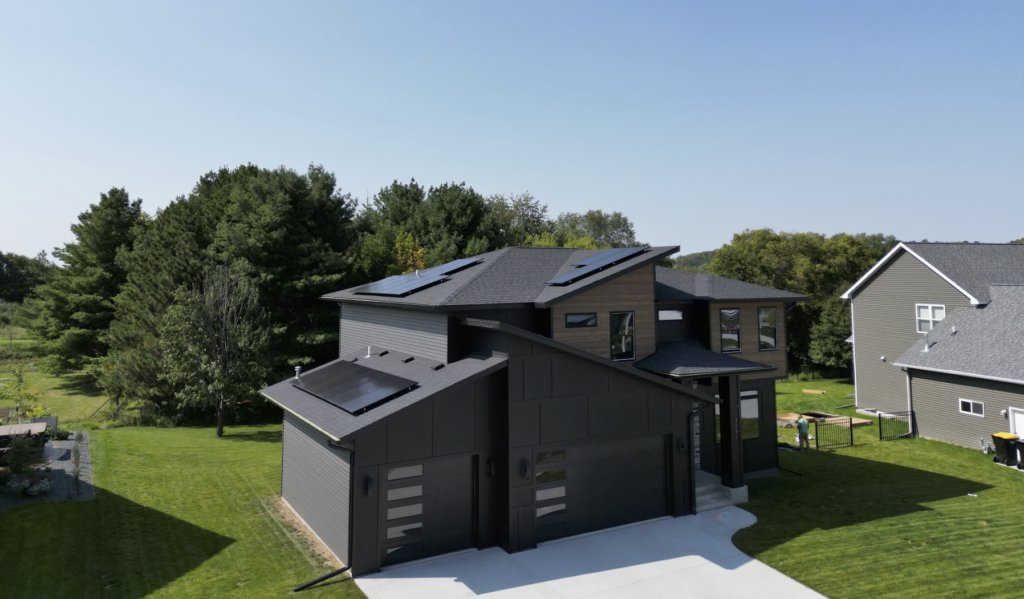Harnessing the power of the sun with a solar energy system is a fantastic way to reduce your reliance on fossil fuels and save money on power bills. Did you know that you can further amplify your solar energy savings by making smart green home improvements? By optimizing your home’s efficiency and incorporating sustainable practices, you can create a harmonious system that minimizes your energy consumption!
Energy Efficiency: The Foundation of Savings
Before diving into advanced technology, it’s crucial to establish a solid foundation of energy efficiency. Here are some key areas to address:
- LED Lighting & Smart Controls: Ditch those old incandescent bulbs! Replacing them with LEDs can slash your lighting energy use by up to 75%, according to the U.S. Department of Energy. Consider smart controls like occupancy sensors or dimming switches for even more savings and convenience.
- Energy Star Appliances & HVAC: When it’s time for new appliances, choose Energy Star-certified models that are proven to be more efficient. Regularly maintain your HVAC system for optimal performance.
- Programmable Thermostats: Take control of your heating and cooling with a programmable thermostat. You can save as much as 10% a year on heating and cooling setting your thermostat back 7°-10°F for 8 hours a day from its normal setting.
- Air Sealing & Insulation: Tiny air leaks around windows, doors, and other openings can lead to significant energy loss. Seal them up and add insulation to your attic, walls, and crawl space to keep your home comfortable and energy-efficient.
Adding Smart Home Tech: Automation for Efficiency
Smart home technology can seamlessly integrate with your solar system, taking your energy management to the next level:
- Smart Thermostats with Solar Integration: Some smart thermostats can connect directly to your solar system, learning your energy usage patterns and automatically adjusting temperatures to maximize solar generation and minimize grid dependence.
- Smart Plugs & Power Strips: Those seemingly insignificant standby lights and electronics add up, creating a “phantom energy drain.” Control individual devices or entire groups with your voice or smartphone, ensuring they only use power when needed. Idle energy use accounts for 23% of power consumption in the average household and represents roughly a quarter of your electricity bill, paid for no good reason.
- Smart Lighting: Automate your lighting with motion sensors and customized schedules for added convenience and energy savings. Imagine your lights turning on automatically as you enter a room and dimming when you leave, creating a truly efficient and personalized lighting experience.

Passive Strategies: Harnessing the Sun’s Natural Power
Let nature lend a helping hand! By incorporating passive solar design principles, you can reduce your reliance on heating and cooling systems:
- Optimize South-Facing Windows: Make the most of the sun’s warmth by maximizing south-facing windows. During winter, sunlight streams through these windows, heating your home naturally. In summer, strategically placed overhangs or blinds can block the sun’s heat.
- Strategic Shade Trees: Plant shade trees on the south and west sides of your home to block harsh summer sun. In winter, when the leaves fall, sunlight can penetrate and provide natural warmth.
- Thermal Mass Materials: Materials like brick, concrete, and stone absorb and retain heat, naturally warming your home in winter and cooling it in summer. Consider incorporating these materials into your home’s design or construction.
Water Conservation: Every Drop Counts
Another way to minimize your consumption and maximize savings is water conservation. Reducing your water usage not only benefits the environment but also lowers your energy consumption, as heating water accounts for a significant portion of home energy use:
- Low-Flow Fixtures: Install low-flow faucets, shower heads, and toilets. These water-efficient fixtures can dramatically reduce your water use without sacrificing performance. The United States Environmental Protection Agency WaterSense-labeled products are certified to use at least 20% less water, save energy, and perform more efficiently than regular models.
- Rainwater Harvesting: Capture the power of rain! Consider installing a rainwater harvesting system to collect rainwater from your roof and use it for watering your lawn, washing your car, etc. The Federal Energy Management Program provides a comprehensive guide on rainwater harvesting.
- Water-Efficient Landscaping: Choose native and drought-resistant plants for your landscaping. Utilize watering techniques like drip irrigation to deliver water directly to plant roots, minimizing waste.
Conclusion: Reap the Rewards
By implementing a combination of these green home improvements, you can create a synergistic system that will minimize energy consumption, reduce your environmental impact, and save you money on utility bills. To maximize your savings even more, see if solar is a good fit for your home!




